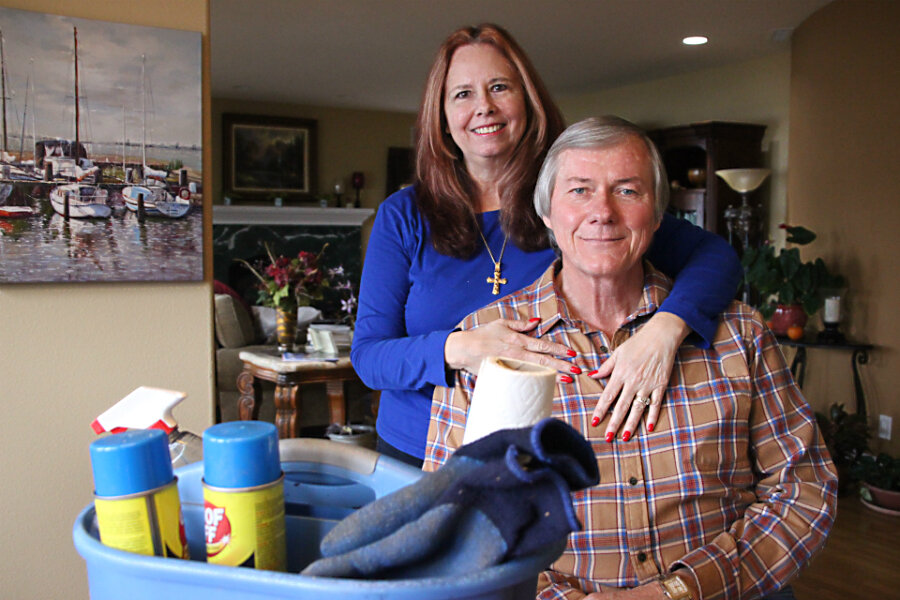How one man is fighting graffiti in his town
Loading...
| Olympia, Wash.
It’s become a familiar scene here. Alan Erickson is driving through town in his pickup truck, heading home. And then it happens.
There, on the side of a building, or on a business sign, Mr. Erickson sees that someone has splattered paint, writing a name or comment. Graffiti strikes again.
Erickson stops, ready for a counterpunch. He reaches in the back of his truck for a bucket of paint, a paintbrush, rubber gloves, and some steel wool.
This is Erickson’s ongoing fight against graffiti.
“I just don’t like the looks of it,” he says. “It takes just a little effort.”
Graffiti is a pretty big problem for a city the size of Olympia (pop. 48,000), the capital of Washington State. In 2015, the city had 1,925 reports of graffiti, an increase of about 500 from the previous year. But in 2016, the number of reports went down to 780.
The 2015 spike is attributed to anti-police sentiment, disturbing comments like “Kill Cops.” “There’s been quite a bit of anti-police stuff,” says Amy Stull, who is the senior program specialist for the Olympia police community programs.
The city holds a few volunteer days each year to battle the graffiti, but Erickson’s fight doesn’t stop.
“It’s pretty cool,” Ms. Stull says about Erickson’s efforts. “It’s one thing to rely on the government for solutions. But it’s always nice when someone takes ownership of our community and does the little bit they can. I just always admire that.”
Erickson’s quick response when he sees tagging is in line with what Olympia police recommend. The key to winning the fight against graffiti, Stull says, is to eliminate it within 24 to 48 hours. Why? The more quickly the graffiti is covered, the bigger a discouragement it is for the person who did it. The individual can’t bask in seeing his or her work.
Erickson gets some help with his mission from his wife, Frances. She’s both a supporter and somebody who reminds him when a job awaits. On walks around their neighborhood, they’ve seen graffiti on mailboxes, a bus stop, and park signs. And with a prod from his wife, Erickson returns with his trusty paintbrush, covering the annoying tagging.
“Oh my gosh. I’m probably worse than he is,” Mrs. Erickson says about her dislike for graffiti.
Mr. Erickson chuckles at his wife’s comment.
“She drives me crazy,” he says with a smile. “It’s, ‘Look, look over there.’ ”
Five years ago, the Ericksons moved from El Paso, Texas, to Olympia, and they’ve fallen in love with their new home.
“We love our community,” Mrs. Erickson says. “That’s the thing. Both of us. When I see the graffiti, it just really irritates me. We’ve got to get rid of it because it’s so beautiful here.”
Mr. Erickson nods in agreement. “It’s my gift back to this area,” he says.
Recently, a local food bank was covered in graffiti, and Erickson says he had fixed it within 48 hours.
With Olympia between Portland, Ore., and Seattle, some of the culprits have been drive-by taggers.
“In my opinion, and this is after looking at it for a number of years, I think it’s almost a compulsive behavior,” Stull says. “I’ve likened it to what we call kleptomania. It’s a compulsion to put your mark on something so the public sees it.”
Erickson goes beyond the initial, emotional response of “isn’t that terrible.” He takes action.
“Because I have stuff in my truck, I can get rid of it fast,” says Erickson, who still owns a real estate business in El Paso. “It’s been my nature my whole life.”
Perhaps surprisingly, the typical tagger isn’t a teenage gang member. Of the 15 people arrested in Olympia for the offense in 2015, they were all males ranging in age from 17 to 51, according to Stull. And the 12 arrests in 2016 consisted of males who were ages 21 to 45. Convicted taggers can face a year in jail and a fine of as much as $5,000.
Erickson encourages others to join in the fight.
“If everyone would spend just 30 minutes a month on getting one project done, imagine what this town would look like,” he says. “Instead of just one or two of us doing this.”
In his ongoing mission, Erickson has partnered with a fellow graffiti-fighter. Anna Schlecht, housing program manager for the city of Olympia, and Erickson have painted several buildings together in downtown Olympia.
“We’ve grown the effort from just patching over graffiti to painting the entire alleys to make them more appealing as walkways for pedestrians and less appealing for dens of iniquity,” Ms. Schlecht says.
And their fight against graffiti continues.







